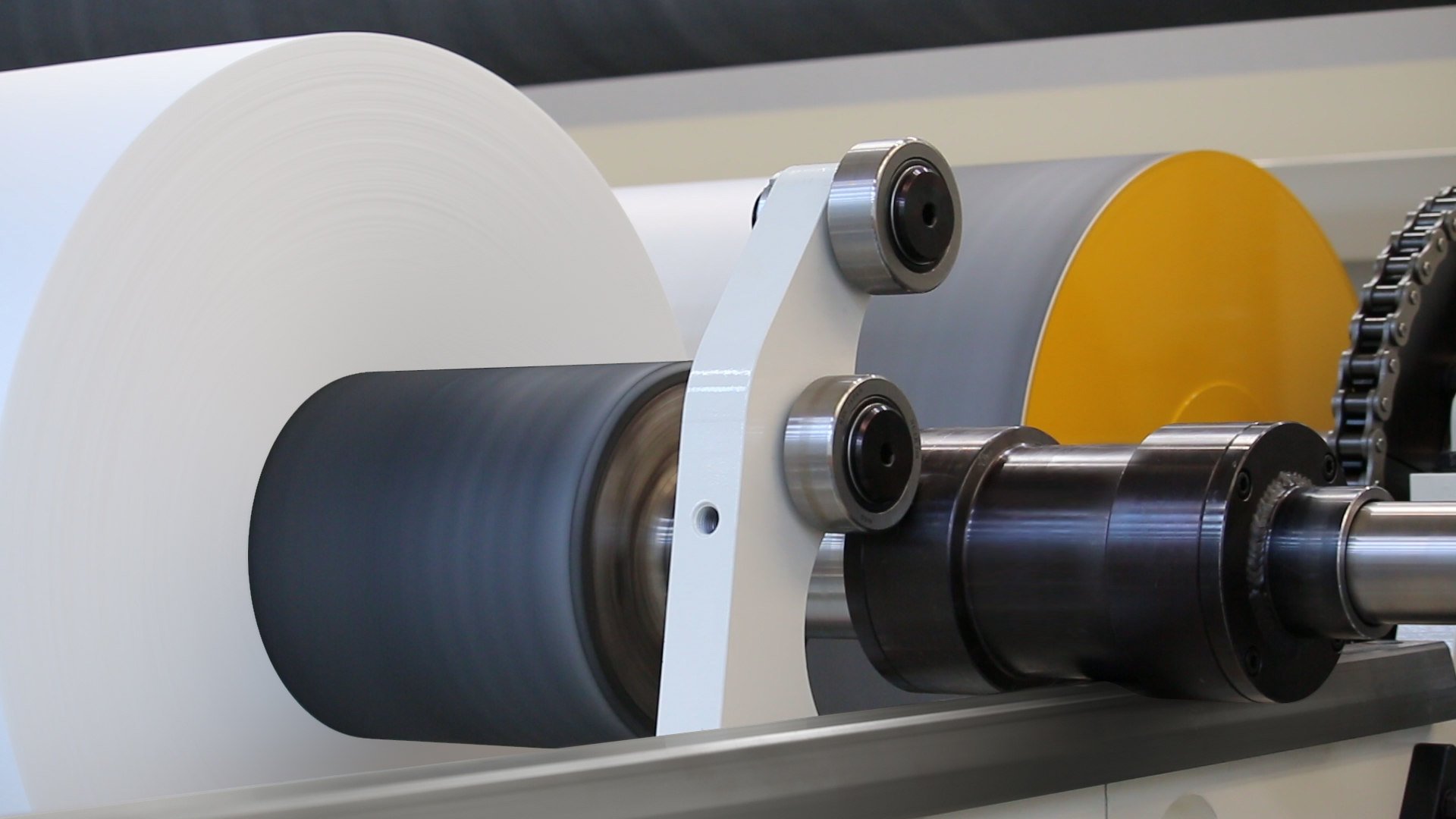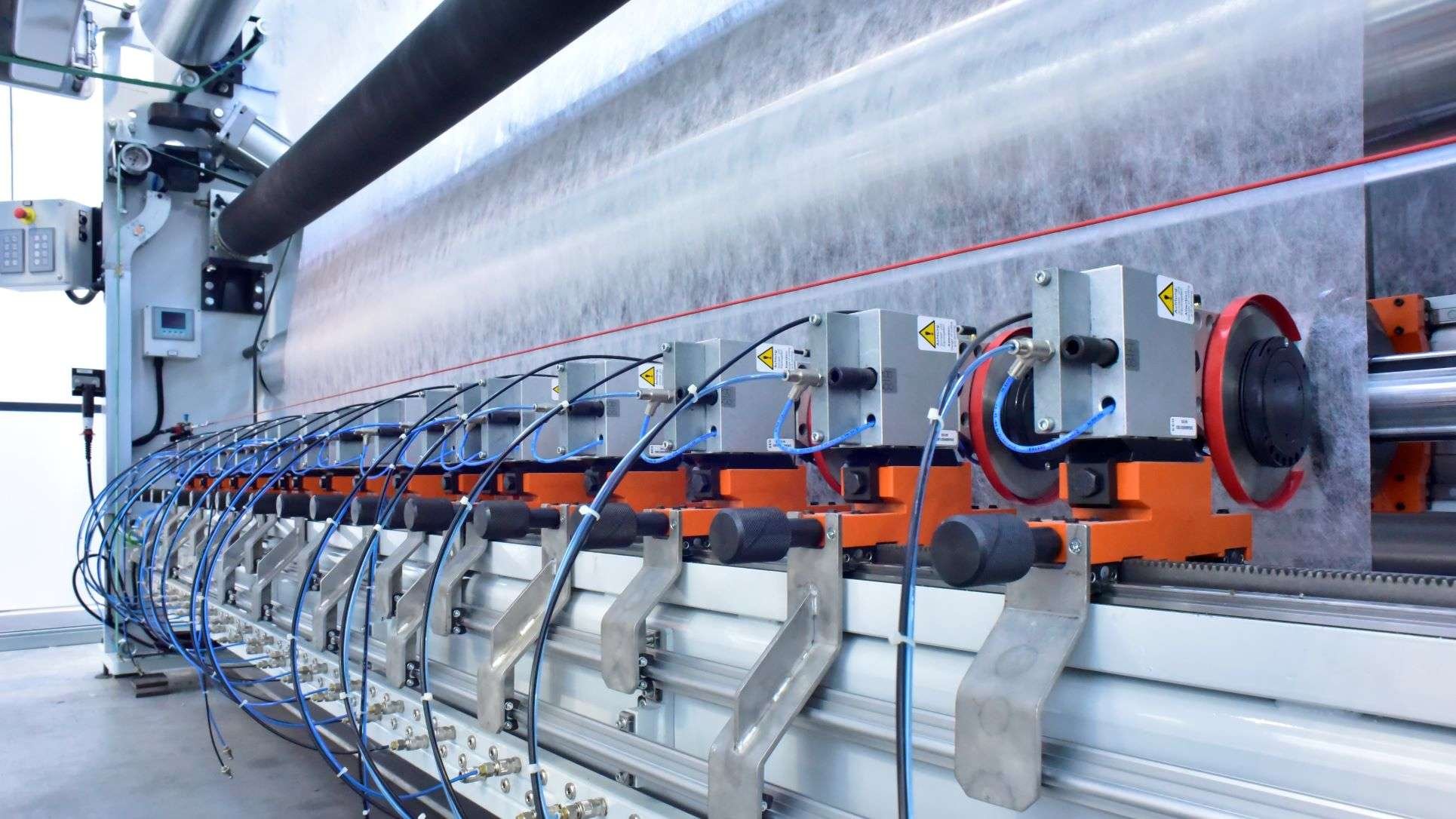[UPDATED ON MARCH 2025]
The operations involving the end-of-line of a nonwoven production plant are extremely important for the quality of the finished reels. The quality achieved in the web formation process can in fact be lost if, starting from the formation of the master roll, the necessary operations are not carried out correctly, taking into account the characteristics of the specific material to be processed.
In this first stage of the "journey" of the nonwoven web through the end-of-line we will talk about the formation of the mother roll and the finished reels, the possible defects that can arise in the event of incorrect winding and rewinding processes and how to avoid them thanks to A.Celli E-WIND® solutions.
The winding process
The first process of the so-called end-of-line involves the formation of the master roll by means of the winder, starting from the continuous nonwoven web coming from the production line. Since the winder has to operate without interruptions according to the speed of the line, it is essential to use a reliable machine that can guarantee continuity of performance over time and, above all, during the critical phase of master roll changing.
The winding can take place with in-line or off-line slitting. In the first case, the nonwoven is wound after being cut into the desired final widths by means of a slitting group formed by a series of knives and counter-knives. The winding takes place around cardboard cores usually held in rotation by an expandable shaft.
Working with in-line slitting allows you to perform the winding operation only once, which is a significant advantage in the case of soft and bulky nonwovens, and leads to a lower capital investment, as it is necessary to purchase only one machine for both processes. On the other hand, the operating speed is generally lower and the change of the knives or the slitting recipe generates waste of material for as long as the slitting is not performed.
As for the off-line slitting, the master roll is formed, as in the the previous case, by winding the nonwoven web around a shaft, generally coated with tungsten carbide. The difference is that, at the end of the process, the mother roll must be transferred from the winder to a separate rewinder to perform the slitting.
This makes it possible, for example, to carry out maintenance activities on a rewinder without necessarily having to stop the line and therefore without wasting material. In this case or for any other reason, in the presence of more lines, the master rolls formed on a specific winder can be picked up (also by means of dedicated automated guided vehicles) and taken to another offline rewinder in operation, with obvious advantages in terms of productivity of the plant as a whole.
Obviously, off-line slitting requires greater initial capital investment and the nonwoven material has to go through two winding cycles.

The rewinding process
At this stage, the aim is to obtain a certain number of nonwoven reels, with a diameter and width defined according to the customer's requirements, starting from the master roll.
Once loaded on the unwinder integrated in the rewinder by means of an overhead crane or automatic loading systems, the mother roll will be unwound while carrying out the checks of the main process parameters (e.g. tension and speed) to ensure a correct execution.
At this point, the nonwoven web is cut by the slitting unit of the rewinder into a number of strips equal to the number of reels required. Each strip is then wound around cardboard cores supported by an expandable shaft, thus achieving the desired final result. The reel forming process takes place between two carrying drums and a rider roll (or pressure roll), the purpose of which is to keep the nip (linear load) under control by applying a certain pressure on the nonwoven reels being formed.
The finished reels are finally unloaded from the rewinder onto an unloading table, pivoting or on rail, while new cardboard cores are loaded onto an expandable shaft using manual or fully automated dedicated systems, thus starting a new cycle.

Defects resulting from incorrect winding and rewinding processes
As mentioned in the opening of the article, errors in the winding and rewinding processes can affect the quality of the nonwoven fabric obtained in the upstream forming line. An incorrect setting of the process parameters can, in fact, give rise to numerous defects. Let's see together the main of these, highlighting the cause.
Excessive tension
If during the winding and rewinding phases we use too high web tension values, we will create excessively compact reels which could have the following defects:
- Loss of product bulk
- Crushed core
- Corrugations: bands of relatively uniform width and equidistant from the edges, characterized by diagonal marks within them and located all around the reel.
Crepe wrinkles: wrinkles in the machine direction at an angle with respect to the axis of the roll; they are weak points that can lead to the breaking of the web
LOOSE TENSION
While excessive tension is definitely to be avoided for the above reasons, using too low a tension value can also lead to numerous problems, including:
- Egg shaped roll
- Reel with flat spots: when the reel is excessively soft and not very compact, the external surface could have a flattened section, even following inaccurate handling operations
- Loose core: if the core rotates at a different speed than the surrounding reel. The rotational displacement may cause the nonwoven web to separate from the core
- Irregular reel profile
- Telescoped roll: a progressive roll edge misalignment due to the slippage of the layers in machine or cross direction. The resulting reels have a concave or convex profile
Taper function setting errors
If, during the winding and rewinding processes, the tension (and, if necessary, the nip and torque) is not reduced as the diameter of the reel increases (taper function), we can encounter, for examples, problems relating to the profile such as telescoping or starring (the presence of a "star" pattern).
Specific defects of the rewinding phase
Rewinding is an extremely delicate phase of the process: from here the finished reels will come out which, in the event of significant defects, could be discarded, leading to loss of material and money. In addition to the defects described above, there are some that are characteristic of the rewinding phase and to which particular attention must be paid:
- Overlapped reels: defect resulting from the overlapping of contiguous strips of material during rewinding
- Defects related to the slitting phase, which can lead to rough and fuzzy roll edges or to the presence of trimmings not properly removed inside the reel
Finally, especially in the case of nonwovens intended for the hygienic-sanitary market, it is absolutely necessary to avoid contamination of the finished rolls by external agents such as dust (resulting from the cutting phase), oil and grease.
Obtain perfect reels using A.Celli E-WIND® solutions
Considering the issues we have just listed, there is only one way to ensure that these processes take place in an optimal manner: using machinery of absolute reliability and quality. Through the E-WIND® product line, A.Celli offers a wide range of solutions that allow you to better manage the end-of-line of your nonwoven production plant, from winding to rewinding.
Entering more in detail, the E-WIND® range allows you to obtain a high final quality of the reels for any type of nonwoven fabric, from standard products, such as spunbond and spunlace, to innovative materials such as high loft nonwovens, which require particular precautions and specific machinery in order to preserve their intrinsic characteristics.
The increase in productivity deriving from the optimization of machine cycle times guaranteed by our machinery should also be emphasized. Operations such as master roll change, knives positioning (which can be carried out through our patented automatic system Slittomatic®), finished reel change cycle, defects management and, generally, the collection of activities which occur when the machine is stopped, are in fact carried out with maximum efficiency.
The A.Celli E-WIND® range allows you to achieve total digital integration of the end-of-line with all upstream and downstream machines, in order to ensure perfect product traceability. Added to this are 3D models via HMI, intuitive diagnostic tools and safety systems developed and implemented following customized risk analysis activities.
Conclusions
Here ends the first stage of the journey of a nonwoven reel. While waiting for the next article, in which we will examine in detail the lamination and flexographic printing phases, why not download our free eBook “A.Celli end-of-line solutions for nonwovens production”? You will surely find the solution that best suits your needs!

